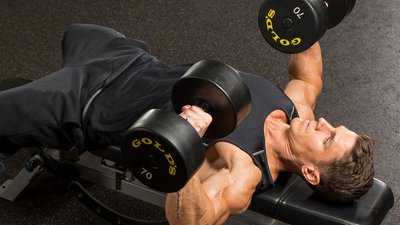As men, it's pretty much engrained in our genetic code to A) miss the toilet when peeing and B) train our chest however and whenever possible. The well-developed chest—unlike that toilet seat—is a sign of masculinity, bravado, (perceived) sexual prowess, and it's also your license to flex your pecs in public whenever the occasion arises … which, is all the time.
To be clear, this appeals to plenty of dudettes, too. I don't want to leave the ladies hanging. Although, admittedly, glutes are seemingly the female lifter's equivalent to pecs nowadays. Which is just fine.
So what's the best way to build that chest? From the time we're young, we're programmed to think it's with the barbell. While many guys with big bench-press numbers do have enviable pecs, there are far more guys with average —if not laughable, by powerlifting standards—bench-press numbers who would make He-Man swoon with their chest development.
Sure, hoisting some heavy-ass weight off your chest, repeatedly, is never a bad approach. But one of the great not-so-secret secrets of the weight room is that, when chest development—not just pushing strength—is the goal, dumbbells almost always beat the barbell.
Why? For one, you have far more options about how to hold, pause, and arrange the weights. Looking to give your chest a kick in the chest? Here are eight places to start:
1. Eccentric-Accentuated Dumbbell Press
Nothing too revolutionary here. All I'm doing in this chest exercise is accentuating the lowering (eccentric) portion to help create more muscle fiber damage and subsequent muscle growth.
I like to keep people in the 3-5-second range as far as the lowering portion is concerned, and aim for 8-12 repetitions. A sneaky trick I'll often implement is a max set on the last set. So it may look something like this:
- Set 1: 10 reps
- Set 2: 8 reps
- Set 3: Max reps
But you can always use straight weight or a pyramid scheme or whatever. It's all good.
2. One-Arm Dumbbell Press
This is a nice way to address any strength imbalances between one side and the other. It also adds an intense core-stability (rotary stability) component as well, as you have to fire all you have to not fall off the bench.
3. Alternating Dumbbell Press
This is a classic variation I always revert back to. I like this one as it kinda-sorta emulates a one-arm press. Plus, it requires—and develops—a fair amount of scapular stability on the straight-arm side as you perform the set.

4. Dumbbell Elevator Press
This technique is something I've seen Ben Bruno discus with goblet squats. Here, the idea is to lower the dumbbell a quarter of the way down, then back up, then lower it halfway down, then back up, then lower it all the way down, then back up again.
That's one rep. It sucks, but in a "holy shit, my pecs are so juicy right now" kind of way. Shoot for 6-10 repetitions.
5. Dumbbell "Reverse Batwing" Press
This variation is the counterpoint to Dan John's batwing row exercise. You hold one dumbbell a few inches above your chest as you perform all your repetitions on the other side.
Switch, and repeat on the opposite side. Ouch.
6. Dumbbell Squeeze Press
As I wrote in my article "Feel the Bench in Your Chest with This Move," this is probably my favorite dumbbell exercise to hammer the pecs. Here you promote two of the major actions of the chest into one hybrid exercise.
The idea here is to squeeze the dumbbells together as you press up and down.
7. Dumbbell Press with Isometric Holds
Hot off the presses! At least for me. (I stole this one from Jim Smith of Diesel Strength & Conditioning.)
The idea here is to, again, increase time under tension in an effort to increase metabolic demand (it burns!) and muscular damage (it hurts!).
Start with a 10-second isometric hold at the top, another 5-second hold halfway down, then another 5-second hold a few inches above the chest. Then, perform 8-10 repetitions.
If you really want to hate life, after you perform your reps, repeat the three separate isometric holds again on your last set.
8. Dumbbell Floor Fly in Hollow Position
This move, that I got from strength coach Joel Seedman, isn't a press, but it's still a very effective exercise to build the pectorals since it's 100 percent adduction. It also hammers the core.
Moreover, since it's performed on the floor, it can be considered a more shoulder-friendly fly variation since it limits the ROM and keeps trainees out of the overextended "danger zone."
Now go pecify those pecs, people.



